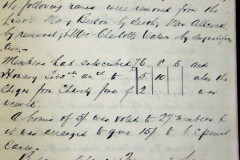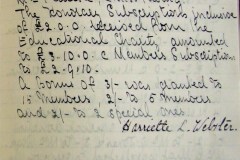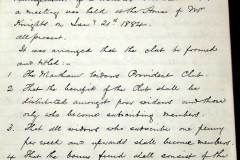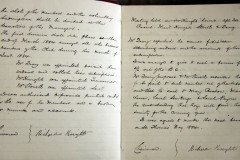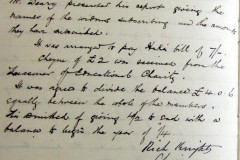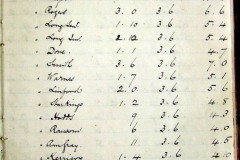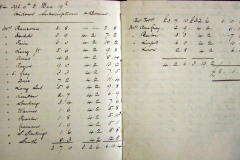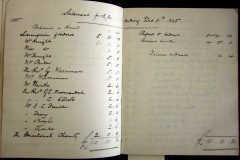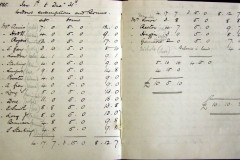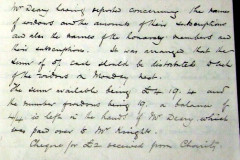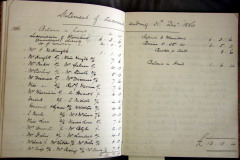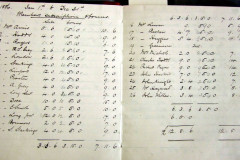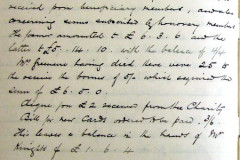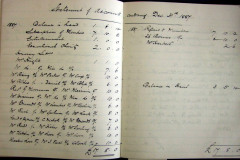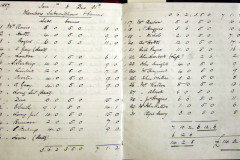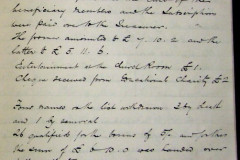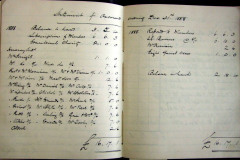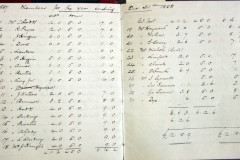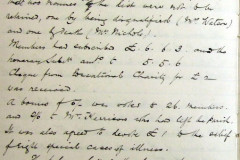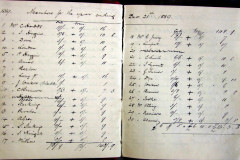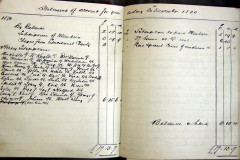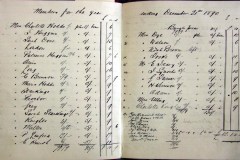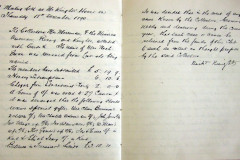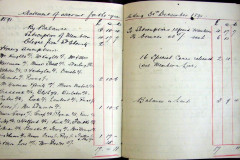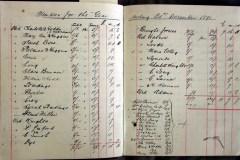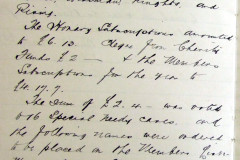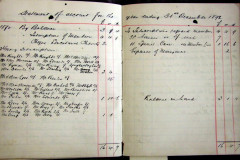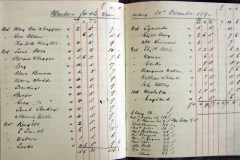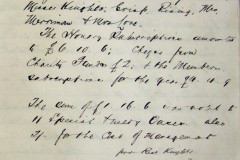Martham Widows Provident Club 1884-1958
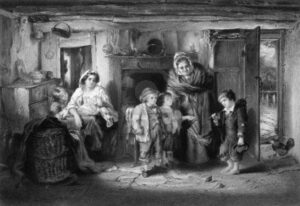
In the late Victorian age a widow could find herself in a unique position. As a married woman she normally enjoyed the guardianship of her husband. He may have only been a poorly paid labourer but somehow they got by. Upon his death, which may have been sudden or early in today’s terms she could easily find herself completely destitute. Indeed, matters could be a whole lot worse for a women left alone to raise her children. By the 1850s life insurance had begun to be available to all social classes but in reality it was not affordable to many, especially to those in rural areas on very low wages.
Widows were often totally reliant on their wider family or Poor Law relief but the latter was not always paid because of complex and variable conditions attached to qualification. Sometimes widows without children only qualified for help for six months following their husband’s death and if they were physically healthy were often judged to be fit and free to find work.
Left penniless their position could be exacerbated by traditional Victorian values where wives did not work but looked after the home and children. As a result, they often had few job skills. They were left with limited choices such as taking in lodgers, washing other peoples clothes, using local pawn shops or money lenders and sometimes even less savoury ways for scraping an income
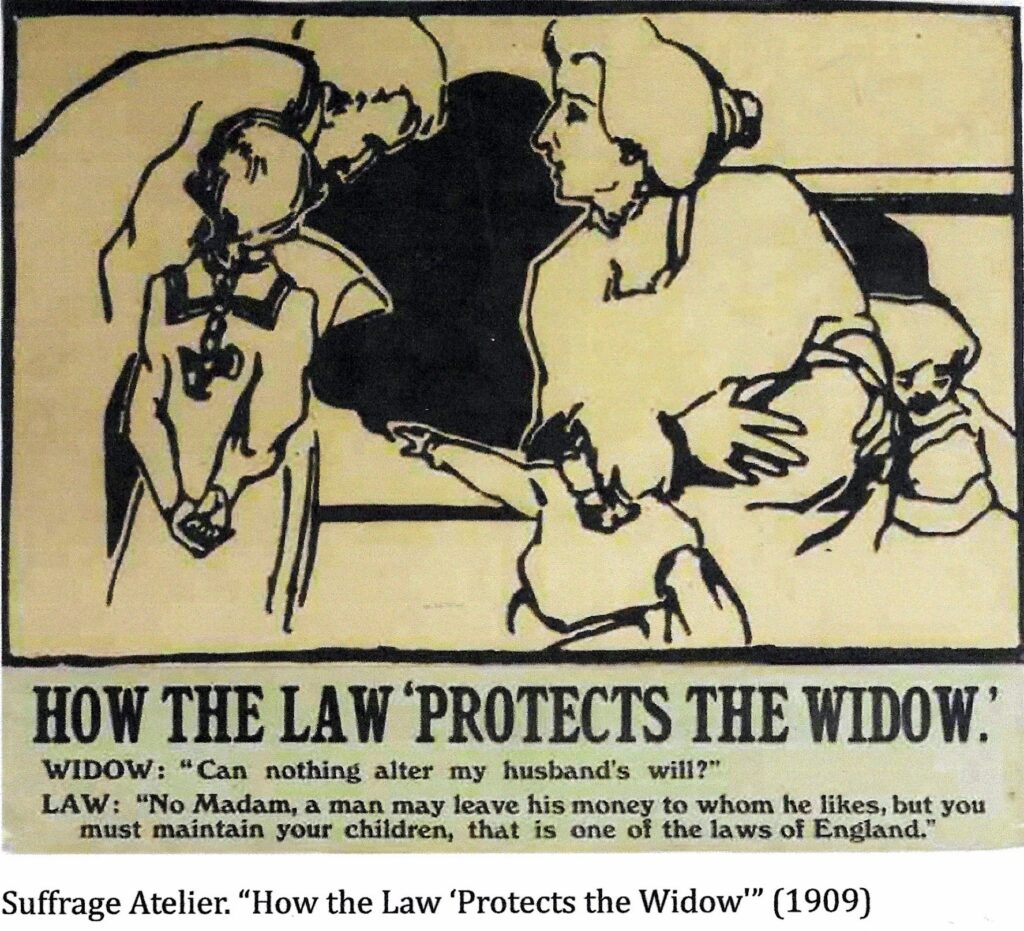
Public awareness and empathy towards the less fortunate grew during the 19th century. Social reformers and writers such as Charles Dickens highlighted the harsh realities faced by the poor, creating a sense of social responsibility among the middle and upper classes. Many religious organisations, voluntary organisations and philanthropists began to take action to address social inequalities and support various groups including the poor, orphans, the disabled, the elderly and widows.
It was against this background that the Martham Widows Provident Club was established in 1884 by the Martham Educational Charity Trustees. Richard Knights, John Deary & the Reverend Charles Stovell met at Mr Knights home on 7th January 1884 to arrange the formation and management of the club. They established the club with the following aims and rules.
1. The benefits of the club will be distributed amongst those poor widows and only those who became subscribing members.
2. That all widows who subscribe one penny per week and upwards shall become members.
3. That the bonus fund shall consist of £2 arranged for in the scheme of the Martham Educational Charity and of voluntary subscriptions (donations).
4. That the £2 shall be equally divided amongst the whole of the members and the voluntary subscriptions shall be divided at the discretion of the managers.
5. The final division shall take place at the end of March 1884 amongst all those who become members of the club during the month of January 1884.
The original Committee was made up of the three men listed above. Richard Knights (1821-1894) was a respected farmer and landowner who at one time farmed at Moregrove and by 1884 lived at what is now known as Manor Farm on Back Lane. John Deary (1826-1892) was a master thatcher, brick maker and coal agent and in 1884 lived at Staithe Road. The Reverend Charles Stovell (1838-1925) was a Baptist Minister and schoolmaster who lived at Brooklyn House on The Green. He left Martham for another post in the Baptist Church in 1891.
Over the 76 year history of the club the Committee members evolved and, perhaps more fittingly, ladies fulfilled the roles. Most of these were daughters of local men who were landowners, farmers or successful businessmen. In those days most single young ladies from this class of society did not work and had little to occupy their time other than helping out with ‘good works’. During its last 50 years or so the Committee appears to have been automatically chaired by the Vicar of the day and at various times included Rev. Webster, Bishop Hamlyn, Rev. Griffiths, Rev. Stenhouse and Rev Kemp.
After the initial period mentioned in five above, the club ran on an annual basis from 1885 to 1958. The Committee met formally in December each year and published details of income received (subscriptions) and grants paid out as well as brief minutes of the meetings. The minutes and account books can be seen in the photographs below at Appendix ‘B’ but a new account book was purchased in 1907 which has been lost so detailed accounts are only available for the period 1884 to 1906 of which an extract is shown at Appendix ‘C’. After that I have extracted basic grant details from the minutes and they are listed in the table at Appendix ‘D’.
Widows paid at least one old penny (just under 0.42 new pence) per week to join the club. There were two other sources of income. The first was £2 per annum paid into the fund by the Martham Educational Charity and the second was voluntary donations, called subscriptions, contributed by the better off of local society. Their names were recorded and can be seen in the account books at Appendix ‘B’. The accounts show that some widows must have used the club as a sort of informal savings bank and paid in more than a penny per week. They got this money back at the time of payout but it did not entitle them to a larger share of the total fund. Payments seem to have been paid out near to Christmas each year.
The records show new members being accepted and others that had died or no longer qualified normally because they had re-married.
The Committee members decided how much should be paid to each member of the club. Sometimes there were very small expenses and in the early years a small balance was usually retained and carried forward to the next year. The accounts also show that in some years ‘special cases’ were given one-off grants and these occasionally included widowers as well as widows.
The accounts provide a useful list of people and cast a light on the social class differences in the village. The widows at the desperate end of society and those that gave donations at the privileged or wealthy end. Most of the accounts only give the widow’s married surname which makes tracing them difficult but in some years forenames are also given and I have added brief details about some of them below at Appendix ‘A’. At the other end of society were those who made donations (sponsors) to the fund and just a few of them were: William Bracey Snr. & his son of the same name, Dr. Anthony Crisp, James C Faulke, Herbert Jeary, Rev. Merriman, James Reeve, The Rising family, Oliver Starling and Mr & Mrs Arthur Wiseman.
The accounts show that income and expenditure changed very little over the course of the first 23 years and then donations began to decrease. Equally the voluntary donations did not keep pace with inflation so the buying power of grants given to widows steadily decreased. £1 in 1884 was equivalent in purchasing power of £5.32 in 1958. According to the Bank of England inflation increased on average by 2.3% per year between 1884 and 1958 although this varied from year to year. In very rough terms you could buy a loaf of bread or pint of beer or 12 eggs for just under two old pence in 1884 (about 0.8 new pence in decimal currency). If you apply the same percentage increase to these products during the course the club was in existence each would cost about 2s 41/2d in 1958 (or just over 11.5 new pence as we know it now). These costs are of course very rough as it would depend on quality, changing ingredients and regional variations. If the same inflation rate was applied to the £2 donated by the charity in 1884 it should have become £28 4s 2d by 1958. Donations should also have gone up considerably but in fact had almost dried up.
These were not the only reasons the club slowly withered. Between 1884 and 1958 massive changes took place in English society. The industrial revolution had an enormous impact on availability of work. For elderly widows, circumstances changed for the better with the Old-Age Pensions Act of 1908, which introduced means-tested state pensions for British men and women over the age of 70. Two World Wars took place. Between the wars, in 1925, Neville Chamberlain introduced the Widows’, Orphans’ and Old Age Contributory Pensions Act that provided 10/- per week for widows.
The chart below shows the steady decline in the voluntary contributions (subscriptions) made between 1907 and 1958 – see the orange line – which all but stopped by 1958. The blue line shows the constant £2 per annum contributed by the Education Charity. The Green line is a reflection of the amounts being saved by the widows themselves so despite getting smaller bonuses they continued to find it a convenient way to save, probably for Christmas expenses. In their eyes the club was obviously particularly worthwhile during the period 1948 to 1952. There is no data for them between 1921 and 1924.
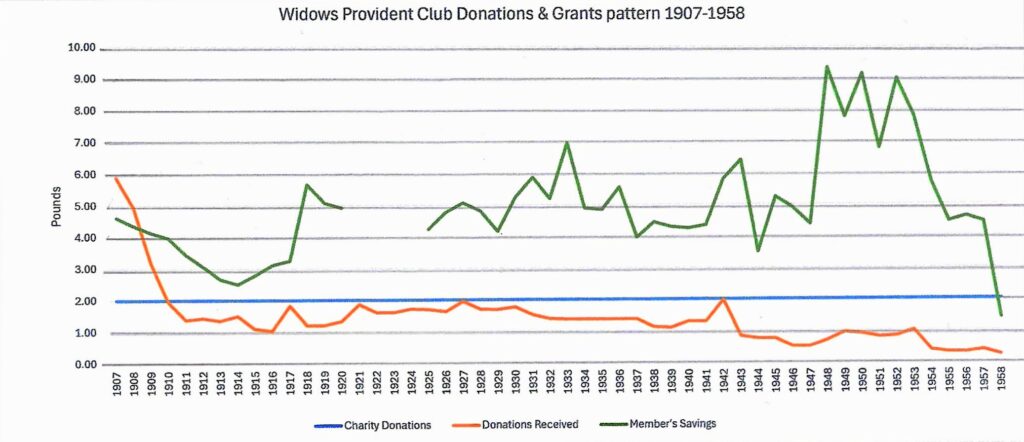
Social changes; the reduction in voluntary donations and inflation slowly rendered the club obsolete. The 1958 minutes were signed off in 1960 and the scheme ceased.
Appendix ‘A’ – Background information about some of the widows.
Clara Brunson was a member of the club from its beginning. She was born at Waxham in 1850 as Clarissa Bishop and married Humphrey Brunson at Martham in 1875. They had six children between 1876 and 1884 but tragically Humphrey drowned at sea whilst working as a fisherman in 1884. After her husband’s death Clara lived at Somerton Road where she was a charwoman. She died in 1928 and was buried with her husband at St Mary’s graveyard at section H, plot J3. Their gravestone is shown on the right.
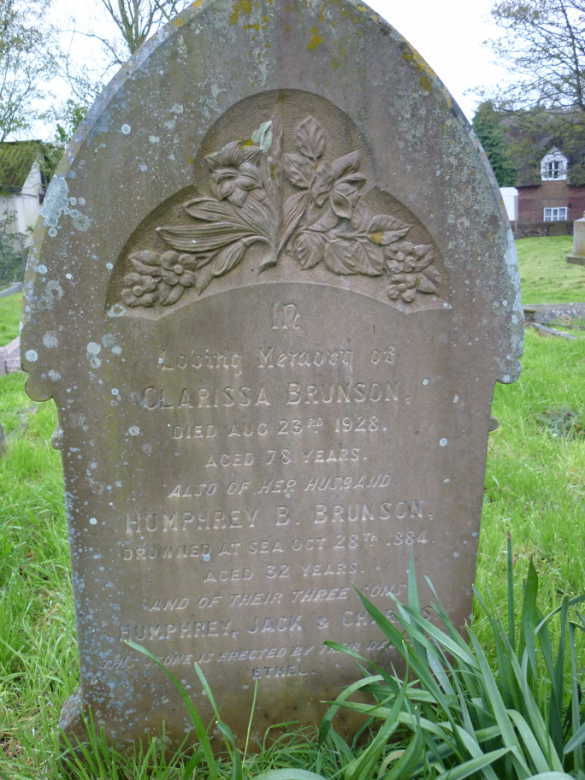
Charlotte Hodds was a long- term member of the club. She was born in 1851 in Martham and married John Watson in 1876. He was a widower and substantially older than her being 59 when they married whilst she was 25. John was a mill and marsh man and died in 1887. Maria appears to have reverted to her maiden name after his death and was given grants under her maiden surname. She lived at Damgate and near Clarkes Farm for most of her life and as a widow had some of her six children to support.
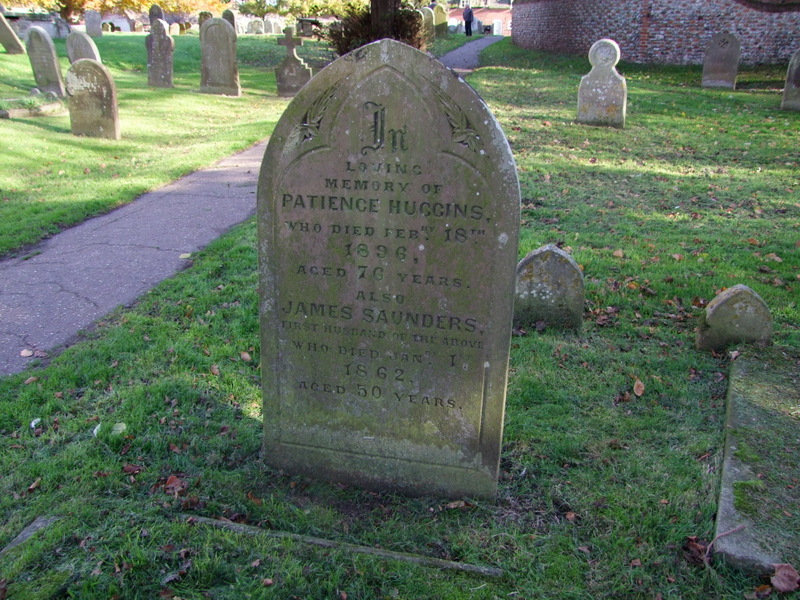
Patience Huggins was a member of the club and received grants from 1886 to 1895. Born Patience Bultitude in 1819 in Martham she married her first husband James Saunders in 1839 at St Mary’s and went on to have at least 10 children. James died in 1862 and Patience married Richard Huggins in 1867 also at St Mary’s. Richard died in 1877 so Patience was actually a widow twice over. Both her husbands were agricultural labourers. Patience died in 1896 and has a fine gravestone that also remembers James Saunders at section A, plot Q1 in the graveyard at St Mary’s.
Maria Utting was a member of the club and received grants in 1890 and 1891. Born Maria Gibbs at Hemsby in 1816 she married William Utting in 1838 at St Mary’s. Willian was an agricultural labourer and died in 1889. Maria died in 1892 and was buried at St Mary’s in an unknown grave.
Caroline Woolstone was a member of the club from the death of her husband George in 1891. Born Caroline Dove in 1839 at Martham she married George in 1857 and they went on the have at least 10 children. George was a fisherman and when he died they were living at Providence Yard in Black Street. Caroline died in 1913 and was buried at St Mary’s in an unknown grave.
Appendix ‘B’ – Photos of minutes and accounts from 1884 to 1958.
Click on any photo to zoom in and from there you will be able to scroll forwards or backwards. After 24 images you will need to select the next page of six.
Appendix ‘C’ – Table of subscriptions and grants 1884 to 1906.
| Martham Widows Provident Club | ||||||
|---|---|---|---|---|---|---|
| Year | Total Income | No. of | Average | Total of | No. Grants | Av. Grant |
| Received (1) | Subscribers | Subscription(2) | Grants Paid(3) | Paid(4) | Paid(5) | |
| 1884 | n/a | n/a | n/a | £12 8s 4d | 20* | 12s 4d |
| 1885 | £10 8s 10d | 13 | 4s 4d | £10 5s 10d | 19* | 10s 10d |
| 1886 | £13 14s 0d | 31 | 3s 7d | £12 8s 6d | 25* | 9s 11d |
| 1887 | £16 1s 0d | 33 | 3s 5d | £14 2s 8d | 30* | 9s 5d |
| 1888 | £13 11s 9d | 27 | 3s 8d | £12 18s 9d | 29* | 8s 11d |
| 1889 | £13 18s 5d | 24 | 4s 7d | £13 3s 5d | 30* | 9s 1d |
| 1890 | £14 15s 3d | 42 | 3s 3d | £14 3s 3d | 37 (9) | 7s 8d |
| 1891 | £13 10s 7d | 39 | 3s 5d | £13 11s 7d | 42 (16) | 6s 6d |
| 1892 | £12 15s 3d | 36 | 3s 7d | £13 1s 3d | 40 (11) | 6s 6d |
| 1893 | £12 10s 2d | 27 | 3s 10d | £13 6s 8d | 36 (6) | 7s 8d |
| 1894 | £11 14s 3d | 21 | 4s 5d | £12 16s 3d | 29 (4) | 7s 9d |
| 1895 | £10 9s 6d | 32 | 2s 4d | £10 7s 6d | 35 (5) | 5s 11d |
| 1896 | £11 2s 5d | 50 | 2s 2d | £10 17s 2d | 33 (6) | 6s 7d |
| 1897 | £11 12s 6d | 49 | 2s 5d | £10 14s 6d | 35 (10) | 6s 2d |
| 1898 | £11 10s 1d | 52 | 2s 3d | £10 10s 10d | 33 (8) | 6s 5d |
| 1899 | £11 1s 0d | 51 | 2s 4d | £10 18s 6d | 35 (8) | 6s 3d |
| 1900 | £10 17s 8d | 46 | 2s 6d | £10 12s 2d | 31 (5) | 6s 10d |
| 1901 | £10 10s 4d | 45 | 2s 10d | £10 2s 4d | 29 (4) | 7s 0d |
| 1902 | £10 14s 8d | 42 | 1s 7d | £11 2s 8d | 34 (10) | 6s 7d |
| 1903 | £13 1s 3d | 47 | 2s 11d | £12 16s 3d | 42 (14) | 6s 1d |
| 1904 | £12 5s 5d | 47 | 2s 11d | £12 6s 5d | 44 (18) | 5s 7d |
| 1905 | £12 7s 7d | 35 | 3s 5d | £12 17s 4d | 39 (12) | 6s 7d |
| 1906 | £12 16s 3d | 37 | 3s 4d | £13 15s 3d | 42 (13) | 6s 7d |
| In pre- decimal currency, 12 pence made one shilling (1/-). 20 shillings made one pound (£1). So, there was 240 pence in one pound. | ||||||
| 1 = Includes the £2 given by the Education Charity plus subscriptions from the widows themselves, plus donations from subscribers. | ||||||
| 2 = The average amount paid in by those who subscribed or made donations (that tended to vary from 1/- to 21/-). Excludes the £2 from the Education Charity and amounts paid in by the widows themselves. | ||||||
| 3 = The total amount paid out to widows from the amount they had saved themselves, distribution of the £2, bonuses from donations and any special grants awarded. | ||||||
| 4 = The total number of grants given inclusive of the number of special grants shown in brackets. There were no special grants given where marked *. | ||||||
| 5 = The average amount of grants given that year including any special grants. | ||||||
Appendix ‘D’ – Table of accounts drawn from minutes 1907 to 1958.
| Martham Widows Provident Club | ||||||||||||||||||||||
|---|---|---|---|---|---|---|---|---|---|---|---|---|---|---|---|---|---|---|---|---|---|---|
| 1907 to 1958 | ||||||||||||||||||||||
| Year | Charity | Donations | Member's | No. of | Chairman | |||||||||||||||||
| Donation | Received | Savings | Members | |||||||||||||||||||
| 1907 | £2 | £5 17s 8d | £4 12s 1d | 30 | Rev. Herbert Webster | |||||||||||||||||
| 1908 | £2 | £4 19s 0d | £4 6s 10d | 26 | Rev. Herbert Webster | |||||||||||||||||
| 1909 | £2 | £3 3s 6d | £4 2s 5d | 25 | Rev. Herbert Webster | |||||||||||||||||
| 1910 | £2 | £1 19s 0d | £3 19s 3d | 22 | Rev. Herbert Webster | |||||||||||||||||
| 1911 | £2 | £1 7s 6d | £3 8s 7d | 25 | Rev. Herbert Webster | |||||||||||||||||
| 1912 | £2 | £1 8s 6d | £3 1s 1d | 23 | Rev. Herbert Webster | |||||||||||||||||
| 1913 | £2 | £1 7s 0d | £2 13s 3d | 23 | Rev. Herbert Webster | |||||||||||||||||
| 1914 | £2 | £1 10s 0d | £2 9s 10d | 22 | Rev. Herbert Webster | |||||||||||||||||
| 1915 | £2 | £1 2s 0d | £2 15s 6d | 18 | Rev. Herbert Webster | |||||||||||||||||
| 1916 | £2 | £1 0s 6d | £3 2s 0d | 19 | Rev. Herbert Webster | |||||||||||||||||
| 1917 | £2 | £1 16s 6d | £3 4s 9d | 19 | Rev. Herbert Webster | |||||||||||||||||
| 1918 | £2 | £1 4s 0d | £5 13s 0d | 19 | Rev. Herbert Webster | |||||||||||||||||
| 1919 | £2 | £1 4s 0d | £5 1s 3d | 19 | Rev. Herbert Webster | |||||||||||||||||
| 1920 | £2 | £1 6s 6d | £4 18s 1d | 23 | Rev. Herbert Webster | |||||||||||||||||
| 1921 | £2 | £1 17s 3d | ? | ? | Bishop Nathaniel Hamlyn | |||||||||||||||||
| 1922 | £2 | £1 12s 0d | ? | ? | Bishop Nathaniel Hamlyn | |||||||||||||||||
| 1923 | £2 | £1 12s 0d | ? | ? | Bishop Nathaniel Hamlyn | |||||||||||||||||
| 1924 | £2 | £1 14s 3d | ? | ? | Bishop Nathaniel Hamlyn | |||||||||||||||||
| 1925 | £2 | £1 14s 0d | £4 4s 5d | ? | Bishop Nathaniel Hamlyn | |||||||||||||||||
| 1926 | £2 | £1 12s 6d | £4 15s 2d | ? | Bishop Nathaniel Hamlyn | |||||||||||||||||
| 1927 | £2 | £1 19s 0d | £5 1s 1d | ? | Bishop Nathaniel Hamlyn | |||||||||||||||||
| 1928 | £2 | £1 14s 0d | £4 15s 11d | ? | Rev. John H Griffiths | |||||||||||||||||
| 1929 | £2 | £1 13s 9d | £4 2s 11d | ? | Rev. John H Griffiths | |||||||||||||||||
| 1930 | £2 | £1 15s 3d | £5 4s 4d | ? | Rev. John H Griffiths | |||||||||||||||||
| 1931 | £2 | £1 10s 3d | £5 17s 0d | ? | Rev. John H Griffiths | |||||||||||||||||
| 1932 | £2 | £1 7s 9d | £5 3s 6d | 17 | Rev. John H Griffiths | |||||||||||||||||
| 1933 | £2 | £1 7s 6d | £6 19s 0d | ? | Rev. John H Griffiths | |||||||||||||||||
| 1934 | £2 | £1 7s 6d | £4 17s 6d | ? | Rev. John H Griffiths | |||||||||||||||||
| 1935 | £2 | £1 7s 6d | £4 16s 6d | ? | Rev. John H Griffiths | |||||||||||||||||
| 1936 | £2 | £1 7s 6d | £5 10s 9d | ? | Rev. John H Griffiths | |||||||||||||||||
| 1937 | £2 | £1 7s 6d | £3 19s 0d | ? | Rev. John H Griffiths | |||||||||||||||||
| 1938 | £2 | £1 2s 6d | £4 8s 6d | ? | Rev. John H Griffiths | |||||||||||||||||
| 1939 | £2 | £1 2s 0d | £4 5s 6d | ? | Rev. John H Griffiths | |||||||||||||||||
| 1940 | £2 | £1 6s 0d | £4 4s 6d | ? | Rev. John H Griffiths | |||||||||||||||||
| 1941 | £2 | £1 6s 0d | £4 6s 6d | ? | Rev. John H Griffiths | |||||||||||||||||
| 1942 | £2 | £1 19s 6d | £5 16s 0d | ? | Rev. John H Griffiths | |||||||||||||||||
| 1943 | £2 | £0 16s 6d | £6 8s 0d | ? | Rev. John H Griffiths | |||||||||||||||||
| 1944 | £2 | £0 15s 0d | £3 9s 9d | ? | Rev. John H Griffiths | |||||||||||||||||
| 1945 | £2 | £0 15s 0d | £5 4s 6d | ? | Rev. John H Griffiths | |||||||||||||||||
| 1946 | £2 | £0 10s 0d | £4 17s 6d | ? | Rev. John H Griffiths | |||||||||||||||||
| 1947 | £2 | £0 10s 0d | £4 7s 0d | ? | Mrs Clara Griffiths | |||||||||||||||||
| 1948 | £2 | £0 14s 0d | £9 6s 3d | ? | Rev. William Stenhouse | |||||||||||||||||
| 1949 | £2 | £0 19s 0d | £7 15s 3d | ? | Rev. William Stenhouse | |||||||||||||||||
| 1950 | £2 | £0 18s 0d | £9 2s 6d | ? | Rev. William Stenhouse | |||||||||||||||||
| 1951 | £2 | £0 16s 0d | £6 15s 6d | ? | Rev. William Stenhouse | |||||||||||||||||
| 1952 | £2 | £0 16s 6d | £8 19s 6d | ? | Rev. William Stenhouse | |||||||||||||||||
| 1953 | £2 | £1 0s 0d | £7 15s 9d | ? | Rev. William Stenhouse | |||||||||||||||||
| 1954 | £2 | £0 7s 6d | £5 13s 6d | ? | Rev. Harry Kemp | |||||||||||||||||
| 1955 | £2 | £0 6s 0d | £4 8s 9d | ? | Rev. Harry Kemp | |||||||||||||||||
| 1956 | £2 | £0 6s 0d | £4 12s 0d | ? | Rev. Harry Kemp | |||||||||||||||||
| 1957 | £2 | £0 7s 6d | £4 8s 6d | ? | Rev. Harry Kemp | |||||||||||||||||
| 1958 | £2 | £0 4s 6d | £1 8s 0d | ? | Rev. Harry Kemp | |||||||||||||||||
